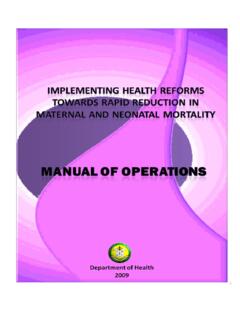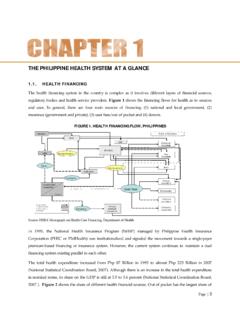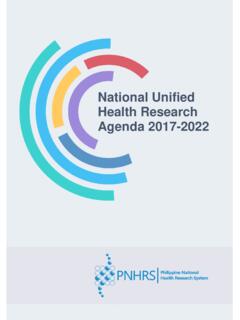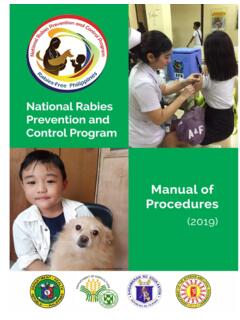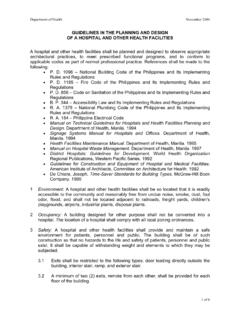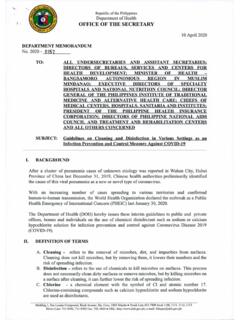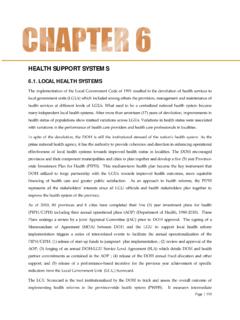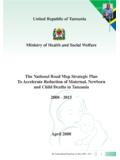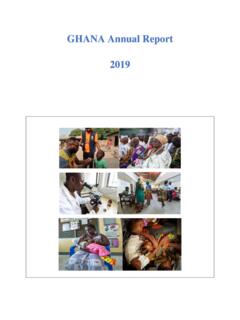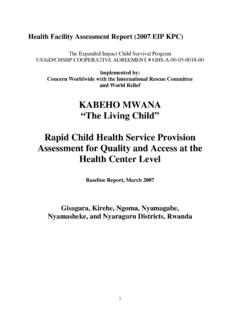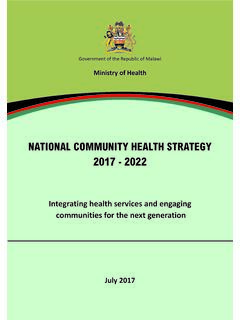Transcription of Department of Health MNCHN Strategy
1 Department of Health MNCHN Strategy Manual of Operations The MNCHN Manual of Operations 2011 2nd Edition, March 27, 2011 Published by the Department of Health , National Center for Disease Prevention and Control San Lazaro Compound, Rizal Avenue, Sta. Cruz, Manila, 1003 Philippines. TELEPHONE +632-651-7800 Electronic copies of this publication can be downloaded at The mention (if any) of specific companies or of certain manufacturer s products does not imply that these are endorsed or recommended by the DOH over other products of a similar nature. Articles may be reproduced in full or in part for non-profit purposes without prior permission, provided credit is given to the DOH. A copy of the reprinted or adapted version provided to the DOH will be appreciated. The MNCHN Manual of Operations 2011 Manila, Republic of the Philippines Department of Health , 2011. The Department of Health acknowledges the support of various staff, LGU partners, technical experts and development partners, who in one way or another, contributed to the development of this revised MNCHN Manual of Operations.
2 Support for the preparation and technical editing of this MOP was provided by the UPecon- Health Policy Development Program, a United States Agency for International Development (USAID) Cooperating Agency. Printing of this MOP was supported by the Women s Health and Safe Motherhood Project 2 financed by the World Bank. TABLE OF CONTENTS Foreword i List of Acronyms iii Definition of Terms v PART 1: INTRODUCTION CHAPTER 1. WHAT IS THE MNCHN MOP? 3 What are the objectives and scope of the MOP? 3 How is the MOP structured? 4 Who are the primary users of the MOP? 5 CHAPTER 2. MNCHN Strategy 7 maternal , newborn , and child Health and Nutrition Situation in the Country 7 Factors Contributing to maternal and newborn Deaths 8 Strategic Response to the MNCHN Situation 9 MNCHN Core Package of Services 10 MNCHN Service Delivery Network (SDN) 12 Health Systems Instruments 14 Policies Related to the Implementation of the MNCHN Strategy 15 PART II.
3 LOCAL IMPLEMENTATION OF THE MNCHN Strategy CHAPTER 3. OVERVIEW 19 Introduction 19 MNCHN Team 20 CHAPTER 4. PRIORITIZE POPULATION GROUPS 23 Know the MNCHN Situation in the LGU 23 Identify Priority Population Groups and Areas 26 CHAPTER 5. DETERMINE THE MNCHN SERVICE DELIVERY NETWORK 29 Define the MNCHN Service Delivery Network 30 Determine Presence of Community Level Providers 30 Designate the CEmONC-Capable Facility or Network of Facilities 32 Designate BEmONC-Capable Network of Facilities and Providers 35 Verify Services by the Designated MNCHN Service Delivery Network 38 CHAPTER 6. STRENGTHEN THE MNCHN SERVICE DELIVERY NETWORK 41 Improve Clients Utilization of Services 41 Assess Gaps 41 Interventions to Increase Client s Utilization of Services 42 Improve Capacity of Health Providers to Deliver Services 46 Organize the Community Health Team 46 Improve the Designated CEmONC-Capable Facility 50 Improve the Designated BEmONC-Capable Network of Facilities and Providers 52 CHAPTER 7.
4 IMPROVE LOCAL Health SYSTEMS 56 Assess Presence of Local Health Systems Instruments 56 Local Health Systems Instruments 56 Governance Measures 57 Regulatory Measures 63 Financing Measures 64 CHAPTER 8. MONITORING PROGRESS 72 Identify Needed Information to Track Progress 72 Determine activities that could be done to collect Information 73 Define the Roles of the MNCHN Team in Monitoring 74 PART III. ROLE OF NATIONAL AGENCIES CHAPTER 9. ROLE OF NATIONAL AGENCIES 79 Department of Health 79 National Centers and Bureaus at the Central Office 79 Health Human Resource and Development Bureau 81 National Center for Health Promotion 81 iii National Center for Health Facilities Development 81 National Epidemiology Center 81 Centers for Health Development 81 Philippine Health Insurance Corporation (PhilHealth) 82 Management Arrangements 84 CHAPTER 10. MONITORING THE IMPLEMENTATION OF THE MNCHN Strategy 87 Health Outcomes and Service Coverage Indicators 87 maternal Death Tracking 87 Process Indicators 88 ANNEXES Annex A.
5 AO 2008-0029 Implementing Health Reforms for Rapid Reduction of maternal and Neonatal Mortality Annex B. MNCHN Core Package of Services and the Service Delivery Network Annex C. Data Validation of MNCHN Service Coverage Indicators Annex D. Assessment of Health Risks and Needs of the Family by CHTs Annex E. Health Plans Annex F. Monitoring Adherence to Health Plans Annex G. MNCHN Provider Competencies Necessary for Adequate Delivery of MNCHN Core Package of Services Annex H. Standard Infrastructure Requirements for BEmONC and CEmONC-capable Facilities Annex I. Logistics and Supplies Necessary for Adequate Delivery of MNCHN Core Package of Services Annex J. Stock and Inventory Management System at the Municipal Level Annex K. Contracting Private Providers Annex L. Annual Operational Plan Matrix LIST OF TABLES Table 1: Evaluation of LGU Performance Using MNCHN Service Coverage Indicators 25 Table 2: Evaluation of LGU Performance Using MNCHN Health Outcome Indicators 25 Table 3: Evaluation of Municipal Performance Using MNCHN Service Coverage Indicators 26 Table 4: Shortlist of CEmONC-capable Facilities 33 Table5: Checklist of Core Services for CEmONC-capable Providers 34 Table 6: Assessment of Clients Utilization of Services 42 Table 7: Service Delivery Gaps and Proposed Interventions for CHT 49 Table 8: Service Delivery Gaps, Proposed Interventions for CEmONC-capable facilities 51 Table 9: Service Delivery Gaps, Proposed Interventions for BEmONC-capable facilities 53 Table 10: Areas for Negotiations for the Service Delivery Network 54 Table 11: MNCHN Monitoring Tool for CHD Provincial Health Team 89 Table 12: MNCHN Monitoring Tool for CHD 90 Table 13.
6 MNCHN Monitoring Tool for NCDPC 91 LIST OF FIGURES Figure 1: maternal Mortality Ratio, 1990-2015 7 Figure 2: Infant Mortality Rate 1990-2015 7 Figure 3: Under-five Mortality Rate, 1990-2015 8 Figure 4: Flowchart of LGU-wide MNCHN Implementation 20 LIST OF BOXES Box 1: Hospitals in the MNCHN Service Delivery Network 16 Box 2: MNCHN Health Indicators 23 Box 3: Data Quality Check 24 Box 4: Community Health Team (Ayod) in Ifugao 31 Box 5: Special Considerations in BEmONC Designation 38 Box 6: Patient Navigation 44 Box 7: Public Private Partnership 62 Box 8: Interlocal Cooperation 71 Box 9: MDR Reporting in Capiz 76 Box 10: MNCHN Grants Facility 80 Foreword The slowing down of the rate of decline in maternal and child mortality in the Philippines places the country at risk of missing its Millennium Development Goal targets of reducing maternal and child mortality. To ensure rapid reduction of maternal and child mortality, the Department of Health (DOH) issued Administrative Order 2008-0029 entitled: Implementing Health Reforms for the Rapid Reduction of maternal and Neonatal Mortality.
7 This Manual of Operations (MOP) for the MNCHN Strategy is intended to guide Local Government Units (LGUs) in designing approaches to deliver MNCHN services especially to populations that are most at risk from maternal and child deaths. In recognition of the differences in local conditions and constraints, the LGU should design the implementation of the MNCHN Strategy based on their local context. The MOP provides for the steps in identifying at risk and priority populations in a given locality, the service packages essential to addressing the MNCHN needs of the target population, the steps in establishing a functional MNCHN service delivery network, the steps to ensure quality of care in delivering MNCHN services, the various financing options to sustain implementation of the Strategy , the mechanisms by which to monitor and evaluate performance and the roles of the DOH central office units, the CHDs, LGUs and other partners in implementing the Strategy .
8 Being addressed to provincial, municipal and city Health officers, program managers and other implementers of the MNCHN program, the MOP also serves as a roadmap in navigating through the various technical guidelines and tools produced by the DOH and its partners for the implementation of the MNCHN Strategy . The DOH commits to supporting the implementation of the MNCHN Strategy in various local government units in the country by providing the technical standards and guidelines for its implementation. The DOH, through its CHDs will also provide technical assistance to LGUs and other partners in adopting the MNCHN Strategy in the context of local Health systems development. Lastly, the DOH will also mobilize and coordinate resources to help LGUs and partners to finance the implementation of the Strategy and linking this with the implementation of local investment plans for Health .
9 Together let us save the lives of Filipino mothers and children. ENRIQUE T. ONA, MD, FPCS, FACS Secretary of Health iii List of Acronyms ANC Antenatal care AOP Annual Operations Plan ARMM Autonomous Region for Muslim Mindanao BCC Behavioural Change Communications BEmONC Basic Emergency Obstetric and newborn Care BHS Barangay Health Station BTL Bilateral tubal ligation CEmONC Comprehensive Emergency Obstetric and newborn Care CHD Centers for Health Development CHO City Health Officer CHT Community Health Team CPR Contraceptive prevalence rate CIPH CSR City-wide Investment Plan for Health Contraceptive Self-Reliance Plan EPI ENC Expanded program on immunization Essential newborn Care FBD Facility-Based Delivery FIC Fully-Immunized Children FP Family Planning GIDA Geographically Isolated and Disadvantaged Areas IEC Information, education, communication ILHZ IMCI Inter-local Health zones Integrated Management of Childhood Illnesses IMR Infant Mortality Rate IUD Intrauterine device LAM Lactation Amenorrhea Method LGU Local Government Unit MMR MDFO maternal Mortality Ratio Municipal Development Fund Office MNCHN maternal , newborn and child Health and Nutrition MOA Memorandum of Agreement MWRA NBS Married Women of Reproductive Age newborn Screening NMR Neonatal mortality rate NSV No-Scalpel Vasectomy PhilHealth Philippine Health Insurance Corporation PHO Provincial Health Officer PIPH/CIPH Province-Wide/City-Wide Investment Plan For Health RHU Rural Health Unit SBA Skilled Birth Attendants SDM Standard Days Method TBA Traditional Birth Attendants UFMR Under-Five Mortality Rate VSC Voluntary Surgical Contraception v Definition of Terms Antenatal care coverage is an indicator of access and use of Health care during pregnancy.
10 It constitutes screening for Health and socioeconomic conditions likely to increase the possibility of specific adverse pregnancy outcomes, providing therapeutic interventions known to be effective; and educating pregnant women about planning for safe birth, emergencies during pregnancy and how to deal with them (WHO; Indicator definitions and metadata 2008). Basic Emergency Obstetric and newborn Care (BEmONC)-Capable network of facilities and providers that can perform the following six signal obstetric functions: (1) parenteral administration of oxytocin in the third stage of labor; (2) parenteral administration of loading dose of anti-convulsants; (3) parenteral administration of initial dose of antibiotics; (4) performance of assisted deliveries (Imminent Breech Delivery); (5) removal of retained products of conception; and (6) manual removal of retained placenta.
